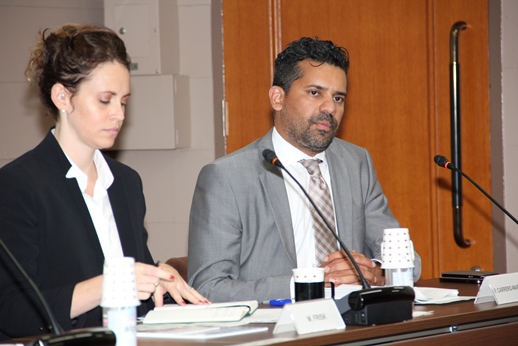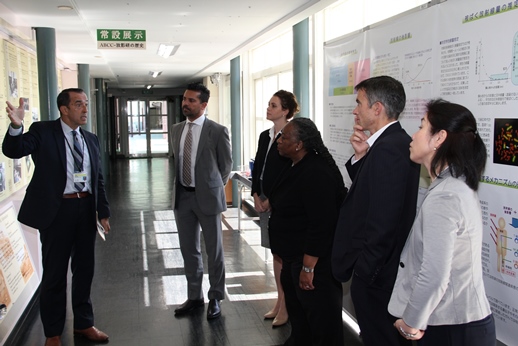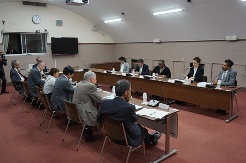- News
U.S. State Department Officials Visit Hiroshima RERF to Talk Science

Dr. Carrero-Martinez (right) and Dr. Frisk (left), during visit to RERF

U.S. State Dept. group listening to explanation of ABCC-RERF history in front of permanent exhibit

Active discussion period in afternoon
On October 4, 2017, United States government officials paid a courtesy and site visit to RERF with the aim of learning about RERF’s science and operations, which are based on the organization’s study of Hiroshima and Nagasaki atomic bomb survivors and their children, whose participation in RERF studies has been crucial for better understanding of radiation’s health effects.
From the U.S. Department of State, Dr. Franklin Carrero-Martinez, a neuroscientist and Acting Deputy Science and Technology Adviser to the U.S. Secretary of State, and Dr. Megan L. Frisk, a chemist and Foreign Affairs Officer, Office of the Science and Technology Adviser to the Secretary, arrived in the morning and had a meeting–which included greetings, an introduction to RERF, and a discussion–with RERF representatives: Dr. Ohtsura Niwa, RERF Chairman; Dr. Robert L. Ullrich, Vice Chairman; Dr. Akira Hashizume, Executive Director; Dr. Eric J. Grant, Associate Chief of Research; and Dr. Kazunori Kodama, Chief Scientist. The two guests also were provided with a presentation about RERF’s funding situation.
Joining Dr. Carrero-Martinez and Dr. Frisk later in the morning were three staff from the U.S. Consulate General Osakag–Kobe: Ms. Karen Kelley, a Senior Foreign Service officer who was appointed as Consul General in late August 2017; Mr. Colin Fishwick, Consul, Political and Economic Affairs, who was stationed until recently in Chengdu, China; and Ms. Naomi Shibui, Political and Economic Specialist.
The combined group listened to a presentation about the history of ABCC–RERF, provided by Dr. Kazunori Kodama, RERF Chief Scientist, who touched on the early foresight of the external scientific committees that prompted ABCC to form longstanding studies of the survivors and their children. After the presentation, the group was taken on a facility tour.
Later, Dr. Eric J. Grant, Associate Chief of Research, explained RERF research. Dr. Grant spoke on the impetus of the establishment of ABCC–RERF’s earliest studies, such as genetics studies and studies of the offspring of survivors. According to Dr. Grant, the study of hereditary effects was thought to be crucial. He touched on RERF’s active research projects and the “bright future ahead of us.” He concluded, “RERF is an amazing example of intergovernmental cooperation and scientific achievement.”
In the afternoon, the guests asked questions of the RERF representatives, including whether RERF was considering new technologies to analyze data (to which RERF responded, ‘yes’), whether RERF was analyzing the microbiome analysis of the survivors (‘no’), whether the organization had conducted any research on the psychological aftereffects of the atomic bombings (‘regrettably, no’), whether political relationships surrounding RERF’s activities were good (‘generally, yes’), and whether prevention of radiation health effects was possible based on RERF data (‘not now, but busy looking for biomarkers of radiation effects, particularly in cancer’).
Dr. Ullrich remarked about the significance of the visit, “I think the meeting went well. I think they learned a lot about what RERF is doing, and they’re going to go back and be supportive of our program.”
